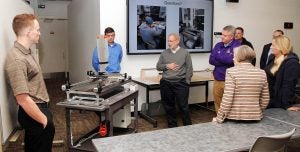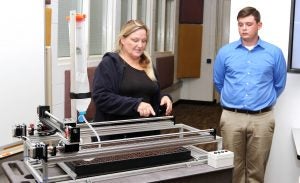ROBO PLANTER
ECU students design machine to improve planting of seeds for wetland plants
Protecting the environment may just start with a robot.
Two East Carolina University industrial engineering technology students have helped create a robotic seed planter for wetland plants that is quicker and more accurate than planting by hand.

Dr. Ellen Colodney, of Wetland Plants Inc., stands with East Carolina University students Josh Robar, left, and Austin Hood who helped create a robotic seed planter for the company as part of a senior project.
Josh Robar and Austin Hood demonstrated the machine for Dr. Ellen Colodney, president of Wetland Plants Inc. in Edenton, as well as faculty and staff of the College of Engineering and Technology.
Wetland Plants grows plants that are designed to increase the performance of stormwater ponds and wetlands that protect water quality from the effect of new land development. The plants help mitigate pollution associated with stormwater runoff.
Colodney explained that the seed for the plants is suspended in a gel. That gel is dropped in small cells of planting trays, but precise amounts of the gel are needed to produce the best yield. Inaccuracy in the amount of gel placed in each tray by hand led to about 50 percent uniformity. With the robotic planter, 90 percent uniformity is expected.
Beyond that, the robot is faster than planting by hand. Placing the gel in the 338 cells of each planting tray takes about 6 minutes with the robotic planter, as opposed to about 20 minutes by hand. For a company that produces about 1.3 million plants per year for sites along the Gulf Coast and up the Atlantic seaboard, the amount of time saved is important.
“I’m thrilled,” Colodney said after watching the demonstration. “Compared to how it was, this is going to be really good. The staff is so excited. They were doing it by hand with droppers, and it took forever and the uniformity wasn’t that good. The seed gel had to be reloaded every 50 cells, so you would get two rows done and have to stop and reload.”

Dr. Harry Ploehn, center, dean of the East Carolina University College of Engineering and Technology, asks questions about a robotic seeder that students Josh Robar, left, and Austin Hood, second from left, helped create to plant wetland plants.
Hood and Robar started their work in late August based on a machine designed and created by Nabeel Mehdi, an analyst with NCGrowth SmartUp. They finished just in time, as Colodney said the business is entering the peak of its planting season.
“I really enjoyed this project,” Hood said. “It gave me a lot of hands-on experience and a lot of experience working within a team and working with a customer. This is exactly what I want to do going forward, working with people on projects.”
Hood and Robar started with the current seed planter, which had some loose parts and exposed wires. The wood construction could rot, and the bulky device proved difficult to move to different locations in the greenhouse.
“Our goals on this project were to make it more durable, make it as rigid as possible and to address as many as Dr. Colodney’s requirements as we could,” Robar said. “The robot must sustain no damage due to the wet environments it would be encountering in the greenhouses, and it has to work in heat up to 100 degrees, so we had to make sure it was made out of a material that wouldn’t have any heat-related decay.”
The students enclosed all the electronics of the device in a box for protection from the elements, and to make the planter more portable, they built it on a cart.
However, the most crucial part of the project was to increase the accuracy and uniformity in which the gel is delivered to the cells in the planting tray, thus increasing yield. Hood and Robar achieved this through improved computer programming and a design that uses guide rails to place the planting tray in the same location every time. The pump used to drop the gel into the trays also starts the process at the exact same position every time, thus increasing accuracy.
“With the pump, we needed to get it as close to the cells as possible, and we needed it to drop the seed right in the middle of the cell,” Robar said. “The nozzle hangs down roughly an inch above the cells, and it drops the perfect amount every time.”
Beyond the construction, the students also had to provide a training manual for the staff that would be using the robot.
“This was a lot of hands-on experience,” Hood said. “In the classroom, you learn a lot of concepts, but we were able to actually work on something.”

Dr. Ellen Colodney, of Wetland Plants Inc., talks about the robotic seed planter that student Austin Hood, right, and Josh Robar helped create.
Hood and Robar delivered the robot on time, but as they were putting it together, saw ways it could be improved, such as creating a second seed pump to increase speed, adding network connectivity that could help with data collection and including audible alarms that could sound if something goes wrong. Those improvements will have to wait for now.
The students said they received plenty of help with the robot, including from Colodney, professors Dr. Jimmy Linn and Bill McClung, fellow students Seth Pierce and Sean Wear, and Scott Snead, director of industry relations for the college, who brought the project to the students.
“This is a real project that really needed to work,” said McClung, who served as the faculty advisor on the project. “Normally a capstone project is where someone comes up with a cool idea, and let’s see if it works. This was a cool idea, but it had to work because you have to get back to business. There was a little more urgency here to make it fly.”
Hood, who graduated Dec. 13, and Robar, who graduates in May, both understood that urgency.
“We were pretty much thrown into this,” Robar said. “It was sink or swim. This wasn’t wishful thinking. If we said we were going to do it, then we had to do it.”
